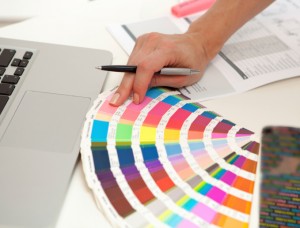
You’ve probably encountered the paint color wheel before.
You’ve probably encountered the paint color wheel before. After all, mixing and matching colors doesn’t come without a modicum of experimentation. Sometimes, you might not know you’ve found the perfect color until you’ve stumbled across it. Even if you didn’t know what it was when comparing possibilities on the Internet, that doesn’t mean you have to stay in the dark forever!
The Deeper Dimensions of True Colors
There’s more to color than what meets your eye. Although every color has a name (even when a color indicates the lack thereof), there are different flavors and variations. The “hue” is the term for the basic color. “Tint” is when a color blends with white, which makes it lighter. And “shade” is when that color is mixed with black, which darkens it. Do you know those days where it’s warm in the sun and cool in the shade? That’s the essence of the deeper dimensions the color wheel presents.
Understanding How the Color Wheel Works
Now that you’ve got a better understanding of colors let’s discuss the concept of the color wheel itself. The conventional wheel features twelve hues. Half of them are considered “cool” colors, while the other half are “warm” colors. Then you’ve got the “primary” colors, the “secondary” colors, and of course, the “tertiary” colors. More follows:
- Primary Colors: Without primary colors, the color wheel wouldn’t be the same. There’s one exception: white doesn’t count as a primary color. The “golden trio” is blue, yellow, and red. These three merge to create the so-called secondary colors.
- Secondary Colors: You get a secondary color when you mix two primary colors, and it’s a perfect balance. These newcomers turn out to be violet (blue + red), green (blue + yellow), and orange (red + yellow).
- Tertiary Colors: Coordinating different colors is tricky. And if you don’t measure out the right amounts, you’ll end up with tertiary colors. These colors aren’t quite either of their parent mixtures. For instance, one part blue and two parts red produce red-violet.
What Does The Term “Monochrome” Mean?
By now, you’re probably aware that “mono” means one. Meanwhile, the word “chrome” brings to mind a metallic finish or a popular Web browser. But what does “monochrome” actually mean? In this context, it’s a scheme that uses the same hue. There are minor differences, though; the differences present themselves through tones, values, and saturation. Gradients take this notion to the next level since it shows you how darker colors transition to their lighter counterparts.
NEW LOCATIONS! VISIT US HERE AND EXPLORE!
We’ve moved from the Dobbin Road location to our new, roomy location just down the road:
Columbia Paint and Decorating, a Benjamin Moore Dealer: 6822 Oak Hall Lane, Suite C2, Columbia MD 21045 phone number: 443-319-4001
Expect the same one-stop shopping for all your decorating needs. We are a full-service Benjamin Moore dealer offering the best quality decorating products at the best prices around. We have ample paint and paint supplies, wallcoverings, custom window treatments, fabrics, and now, NEW flooring selections from Kaleen Rugs and Luxury Vinyl Tile samples. And, of course, the same excellent customer service, knowledge, and customer satisfaction that you’ve come to expect.
ANNOUNCING OUR SECOND LOCATION:
Clarksville Paint & Decorating, a Benjamin Moore Dealer
12447 Clarksville Pike, Suite 1A, Clarksville, MD


